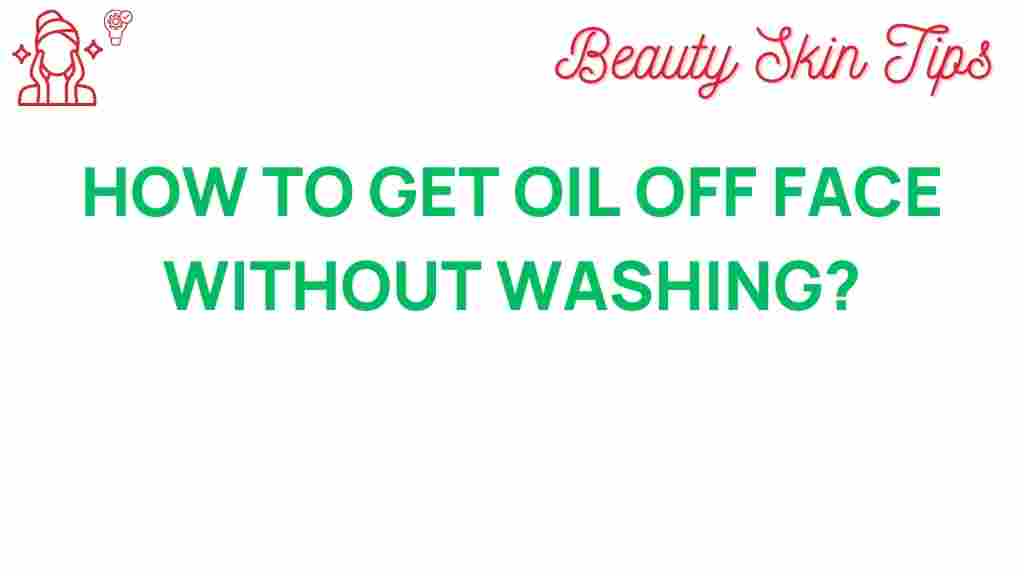Oil Removal: The Surprising Secrets to Removing Oil from Your Face Without Washing
Many individuals struggle with excess oil on their face, which can lead to a shiny appearance and even acne breakouts. While most people immediately think of washing their face to combat this issue, there are effective techniques for oil removal that don’t involve water or traditional cleansing methods. In this guide, we will explore surprising secrets to effectively remove oil from your face without washing, along with tips, tricks, and common troubleshooting advice.
Understanding Oil on Your Face
Before we delve into methods for oil removal, it’s essential to understand why your skin produces oil. Sebaceous glands in your skin release sebum, a natural oil that helps keep your skin moisturized and protected. However, factors such as hormones, diet, and skin type can lead to an overproduction of oil.
Here are some common reasons for excess oil production:
- Hormonal changes (e.g., puberty, menstruation, pregnancy)
- Diet high in sugars and unhealthy fats
- Genetics and skin type (oily skin types produce more sebum)
- Environmental factors (humidity and heat)
Why Avoid Washing Your Face?
While washing your face is a standard practice, it can sometimes strip your skin of its natural oils, leading to a rebound effect where your skin produces even more oil to compensate. Here are some reasons to consider oil removal techniques without washing:
- Maintaining the skin’s natural moisture balance
- Preventing dryness and irritation
- Convenience, especially when you’re on the go
Surprising Techniques for Oil Removal
Now that we understand the basics, let’s explore some surprising methods for effective oil removal without washing your face.
1. Blotting Papers
Blotting papers are one of the simplest and most effective tools for oil removal. They quickly absorb excess oil without disturbing your makeup or skin barrier.
**How to Use:**
- Gently press a blotting paper against oily areas of your face.
- Hold it for a few seconds to allow the paper to absorb the oil.
- Discard the used paper and repeat as necessary.
2. Cornstarch or Rice Powder
Using cornstarch or rice powder can help absorb oil effectively. These powders are lightweight and can act as a natural mattifier.
**How to Use:**
- Take a small amount of cornstarch or rice powder on your fingertips.
- Lightly dust it over the oily areas of your face.
- Gently blend it in with a brush or your fingers.
3. Oil-Free Moisturizers
Opting for oil-free moisturizers can assist in managing oil production. These products hydrate your skin without adding excess oil.
**How to Use:**
- Apply an oil-free moisturizer after your normal skincare routine.
- Focus on areas prone to oiliness, such as the T-zone.
4. Use of Facial Mists
Facial mists can refresh your skin and help manage oiliness without the need for washing. Look for mists that contain ingredients like witch hazel or tea tree oil.
**How to Use:**
- Spray a light mist over your face, avoiding the eye area.
- Allow it to air dry, and it will help absorb some oil.
5. Apple Cider Vinegar
Apple cider vinegar is known for its astringent properties, making it an excellent choice for oil removal.
**How to Use:**
- Mix equal parts of apple cider vinegar and water in a spray bottle.
- Spray it on your face and let it dry.
- This can help to balance your skin’s pH and control oil production.
Step-by-Step Process for Oil Removal Without Washing
To effectively incorporate these techniques into your routine, follow this simple step-by-step process:
- Assess Your Skin: Determine which areas of your face are oily and require attention.
- Choose Your Method: Select one or more methods from the techniques mentioned above based on your preference.
- Prepare Your Products: Gather the necessary tools, such as blotting papers, powders, or facial mists.
- Apply the Chosen Method: Follow the instructions for your selected oil removal technique.
- Evaluate Results: Check your face in the mirror to assess the effectiveness and reapply if needed.
Troubleshooting Common Issues
Even with the best techniques for oil removal, you may encounter some challenges. Here are common issues and how to address them:
1. Powder Leaves a White Residue
If you use cornstarch or rice powder and notice a white residue, try using a makeup brush to blend it in more thoroughly or choose a tinted powder that matches your skin tone.
2. Blotting Papers Aren’t Effective
If blotting papers don’t seem to absorb oil well, try using multiple sheets in one application. Press gently but firmly to maximize absorption.
3. Skin Feels Tight After Using Vinegar
If you feel tightness or irritation after using apple cider vinegar, dilute it further with more water or reduce the frequency of use.
Conclusion
Removing oil from your face without washing is entirely feasible with the right techniques and products. By employing methods such as blotting papers, powders, and natural astringents, you can effectively manage excess oil while maintaining your skin’s health. Remember to choose the method that best suits your skin type and lifestyle. For more tips on skincare routines, visit our skincare guide.
With these surprising secrets for oil removal, you can say goodbye to unwanted shine and hello to a fresh, matte complexion at any time of the day!
For further reading on skincare, check out this external resource.
This article is in the category Skincare and created by BeautySkinTips Team
